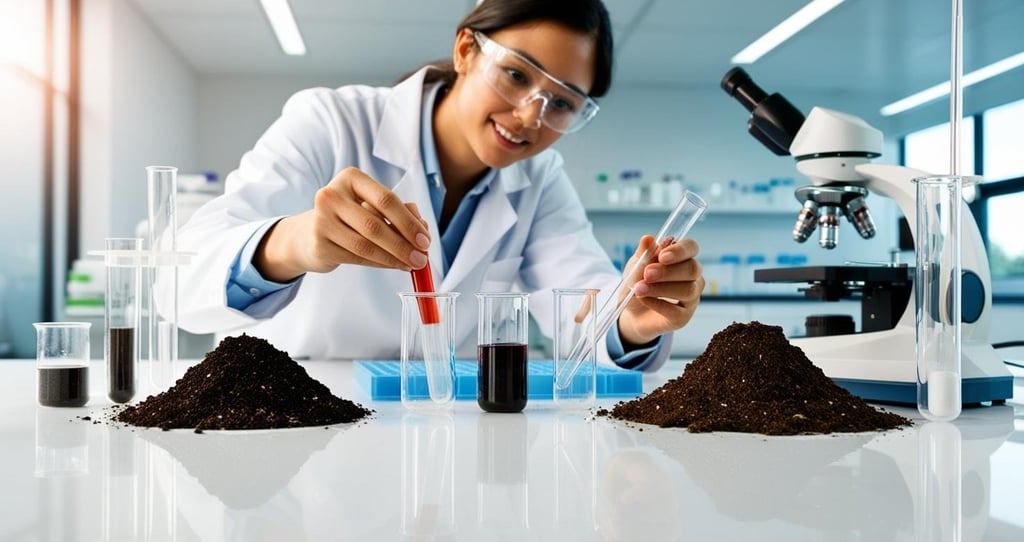Why Soil Testing is Essential for Higher Yields?
Soil testing is a fundamental agricultural practice that involves analyzing soil samples to assess their nutrient content, pH levels, and overall health. This process provides vital information about the physical and chemical properties of soil, which are essential for effective crop management and sustainable gardening.
SOIL HEALTH & FERTILITY
Mr. Rajesh Budhe
4/2/20258 min read


Introduction to Soil Testing
Soil testing is a fundamental agricultural practice that involves analyzing soil samples to assess their nutrient content, pH levels, and overall health. This process provides vital information about the physical and chemical properties of soil, which are essential for effective crop management and sustainable gardening. By conducting soil tests, farmers and gardeners can make informed decisions regarding fertilization, crop selection, and soil amendment, ultimately leading to enhanced productivity and optimal yields.
The importance of soil health cannot be overstated. Healthy soil is the foundation of successful agriculture; it directly influences plant growth, nutrient availability, and water retention. Soil testing allows growers to evaluate their soil's capacity to supply essential nutrients such as nitrogen, phosphorus, and potassium. Additionally, it helps identify potential deficiencies or toxicities that could impede plant development. Recognizing the specific needs of the soil is crucial in developing a targeted management plan that promotes sustainable practices.
In addition to nutrient analysis, soil testing provides insights into the soil's pH level, which affects nutrient availability and microbial activity. Different crops thrive at varying pH levels, making this information essential for selecting appropriate crops that will perform well in specific soil conditions. Regular soil testing enables farmers to track changes over time, ensuring that soil health is maintained, and productivity remains high.
In summary, soil testing is an indispensable tool for anyone involved in agriculture or gardening. It empowers individuals to understand their soil's composition, aids in resource management, and contributes to the overall goal of achieving higher yields while promoting environmental stewardship. Implementing regular soil testing as part of a comprehensive soil management strategy is a proactive step toward sustaining agricultural productivity and ecosystem health.
The Benefits of Soil Testing
Soil testing is a critical practice for agricultural success, providing numerous benefits that enhance productivity and sustainability. One of the primary advantages of soil testing is improved nutrient management. By assessing the nutrient composition of the soil, farmers can identify specific deficiencies and surpluses. This knowledge facilitates customized fertilization strategies, ensuring that crops receive the precise nutrients required for optimal growth. As a result, farmers are less likely to over-fertilize, which can lead to nutrient runoff and environmental harm, while also reducing input costs.
Another significant benefit of soil testing is the identification of soil pH levels. Soil pH plays a crucial role in nutrient availability; certain nutrients are only accessible to plants at specific pH ranges. By determining the pH of the soil, farmers can adjust it to enhance nutrient uptake. For example, if the soil is too acidic or alkaline, amendments such as lime or sulfur can be applied to correct the pH, fostering a more suitable environment for healthy crop development.
Furthermore, soil testing empowers farmers to effectively tailor their fertilization strategies. With detailed insights into nutrient needs, soil composition, and pH levels, farmers can create precise, data-driven plans that maximize crop health and yield. This tailored approach not only promotes efficiency in resource use but also contributes to the ecological balance by minimizing excess fertilizer application. Consequently, healthy crops thrive, leading to increased yields and better economic returns for farmers.
In essence, the practice of soil testing supports the goal of sustainable agriculture by optimizing resource use, promoting environmental stewardship, and enhancing overall farm productivity. Therefore, investing in soil testing can lead to significant long-term benefits for both farmers and the agricultural sector as a whole.
Understanding Soil Composition
Soil is a complex mixture composed of various components, each playing a crucial role in determining its overall fertility and suitability for plant growth. The primary components of soil include minerals, organic matter, water, and air. Understanding the composition of these elements is essential for effective soil management, which directly impacts agricultural yields.
Minerals are derived from the weathering of rocks and provide essential nutrients like nitrogen, phosphorus, and potassium, which are vital for plant development. These nutrients are crucial in supporting plant processes such as photosynthesis, root development, and flowering. The availability of these minerals can vary significantly based on soil type, which is why soil testing is vital. It helps identify nutrient deficiencies or imbalances, enabling the appropriate amendments to be made.
Organic matter, composed of decomposed plant and animal residues, serves several functions in soil health. It enhances soil structure, improves moisture retention, and acts as a reservoir for essential nutrients. High levels of organic matter often indicate a fertile soil that can support robust crop growth. Soil testing that includes organic matter assessment can provide insight into the biological activity within the soil, which is a good indicator of overall soil health.
Water and air are equally important components of soil composition. Water serves as a solvent for nutrients, facilitating their uptake by plants, while air is essential for the respiration of soil organisms and plant roots. The balance between these two elements can influence soil aeration and drainage, both of which are critical for sustainable agriculture. Testing soil moisture levels can help determine appropriate irrigation strategies to prevent waterlogging or drought stress.
By understanding the intricate relationships among these components through soil testing, farmers and gardeners can make informed decisions to enhance soil fertility and ultimately achieve higher yields.
The Soil Testing Process
Soil testing is a critical aspect of agricultural management that ensures optimal crop production. The process typically begins with the collection of soil samples from the field, which requires careful consideration to obtain representative samples. To collect soil samples accurately, one should select multiple locations within the field to avoid bias, ensuring to take samples from different areas that may exhibit variability in soil type or nutrient levels. A soil probe or auger is often employed for this purpose, extracting samples from the root zone of crops, usually between 6 to 8 inches deep. The gathered samples should be combined into a single composite sample in a clean container to reflect the overall condition of the field.
Following collection, samples must be sent to a reputable soil testing laboratory for analysis. Several types of soil tests exist, each serving specific purposes. The most common test evaluates soil pH, which affects nutrient availability and microbial activity. Additionally, nutrient analysis tests for essential macronutrients, such as nitrogen, phosphorus, and potassium, along with micronutrients like zinc and iron, providing crucial insights into soil fertility. Another important test can assess soil texture, indicating the proportion of sand, silt, and clay, which influences water retention and drainage capabilities.
Once the laboratory results are received, interpretation is key to making informed decisions regarding soil management. Many laboratories provide recommendations based on the test results, helping farmers understand how to amend their soil effectively. Understanding the nutrient levels in the soil helps in determining appropriate fertilization practices, while adjustments to pH levels can rectify any acidity or alkalinity issues. Implementing these findings allows for improved crop yields and sustainable farming practices. Utilizing proper sampling techniques and understanding the testing process is imperative for harnessing the full potential of the soil.
Common Soil Issues Identified through Testing
Soil testing serves as a crucial diagnostic tool for identifying various soil-related issues that can significantly affect crop yields and overall soil health. One of the most common problems revealed through testing is nutrient deficiency. Essential nutrients such as nitrogen, phosphorus, and potassium may be insufficient, leading to stunted growth and reduced productivity in crops. For instance, nitrogen deficiency often manifests in yellowing leaves and poor plant development, while phosphorus deficiency can result in delayed maturity and reduced fruit quality.
In addition to deficiencies, soil tests frequently reveal nutrient imbalances. This occurs when certain nutrients are present in excessive amounts while others are lacking, which can inhibit crop growth. For example, an overabundance of potassium can lead to magnesium deficiency, adversely affecting the plant's ability to uptake other vital elements. Balancing these nutrients is key to promoting optimal plant development and securing higher yields.
Soil contamination is another critical issue that soil testing can uncover. Contaminants such as heavy metals, pesticides, and pathogens can degrade soil quality, posing risks to both plant health and human safety. The presence of such contaminants can lead to reduced crop yields and may also result in long-term repercussions for soil fertility. Regular testing can play a vital role in identifying these contaminants early, allowing farmers to take corrective actions to mitigate their impact.
Addressing the soil issues identified through testing is essential for not only boosting crop productivity but also ensuring the sustainability of the agricultural ecosystem. By understanding the specific deficiencies, imbalances, and contaminants present in the soil, farmers can implement targeted strategies aimed at enhancing soil health and achieving higher yields. This proactive approach ultimately contributes to a more sustainable agricultural practice.
Implementing Test Results for Higher Yields
Once soil tests have been conducted and results analyzed, the next crucial step is utilizing these findings to enhance agricultural productivity. Effective use of soil test outcomes can lead to informed decisions regarding fertilization, cover cropping, and overall soil management practices. Properly interpreting soil nutrient levels, pH, and organic matter content enables farmers to tailor their practices to meet specific soil conditions and crop requirements.
One of the primary strategies is adjusting fertilization practices based on the nutrient deficiencies identified through soil testing. For example, if a soil test reveals a low phosphorus level, applying a phosphorus-rich fertilizer can significantly improve crop growth and yield. Conversely, if soil tests indicate sufficient nutrient levels, applying excessive fertilizers could not only be wasteful but also harmful to the environment. Understanding these results allows farmers to apply nutrients only when necessary, promoting sustainable practices.
Another effective approach is adopting cover cropping based on soil test recommendations. Cover crops enhance soil health by preventing erosion, improving soil structure, and increasing organic matter. If soil tests suggest low organic matter, planting cover crops during fallow periods can help build it up. These crops not only contribute nutrients back into the soil but also serve as a living mulch that reduces weeds and conserves moisture, all contributing to higher yields in subsequent growing seasons.
Moreover, soil test results can influence irrigation strategies. Identifying soil moisture retention capabilities aids in determining the optimal irrigation approach, which can prevent overwatering or drought stress that negatively impacts crop yields. In summary, utilizing soil test results effectively empowers farmers to implement tailored soil management techniques, which can lead to increased agricultural productivity while fostering sustainable practices.
Conclusion: Investing in Soil Testing for Sustainable Agriculture
In the contemporary landscape of agriculture, the significance of soil testing cannot be overstated. This essential practice serves as the cornerstone for achieving higher yields and enhancing overall farming efficiency. By assessing the nutrient composition, pH level, and other critical factors of soil, farmers can make informed decisions about their crop management practices, ultimately leading to improved productivity and sustainable agriculture.
The process of regular soil testing is not merely a one-time task but rather a vital investment in the long-term health of agricultural land. It empowers farmers to tailor their fertilization and amendment strategies based on actual soil conditions rather than relying on generalized recommendations. This specific approach minimizes waste, optimizes resource use, and fosters a more environmentally sustainable farming practice. Moreover, understanding the intricacies of soil health contributes significantly to enhancing the resilience of crops against pests and diseases, thereby skyrocketing food production capabilities.
Moreover, as global populations continue to rise, the demand for food will only increase. Farmers who prioritize soil testing are better equipped to meet these demands through sustainably managed agricultural systems. The calculated insights gained from soil tests pave the way for realizing higher yields while concurrently enriching the soil ecosystem. This not only benefits current agricultural output but also secures the viability of soil for future generations.
In essence, investing in soil testing is a proactive strategy that aligns with sustainable agriculture objectives. It enables farmers to harness the full potential of their land, ensuring productive and responsible farming practices that contribute to food security and ecological balance. By prioritizing soil health through informed, science-based decisions, agriculture can thrive sustainably now and into the future.
Contact for Soil Testing:
Frosil Agrosciences
Office: Gat No. 96, Near Krushnai Hospital, Tandali,
Taluka: Shirur,
District: Pune,
Pin Code: 412211.
Customer Care: +91 8329592991
Email: support@frosil.com


"Boosting Crop Growth With Nature's Power"
Contact Us:
E Mail: support@frosil.com
Customer Care: +91 8329592991
FROSIL © 2025. All rights reserved.


'Frosil' is a fertilizer manufacturer committed to enhancing soil health and crop yields. We provide high-quality, eco-friendly products that support sustainable agriculture and help farmers achieve optimal results.
Registered Office: Gat No.96, Near Krushnai Hospital, Tandali. Tal- Shirur, Dist- Pune.
